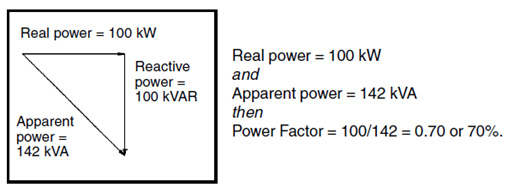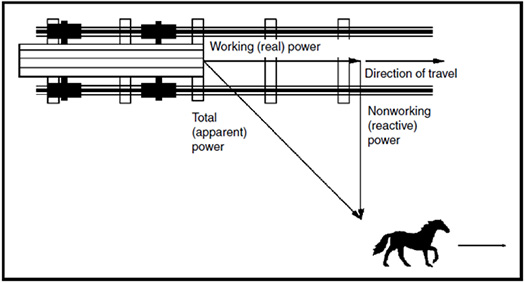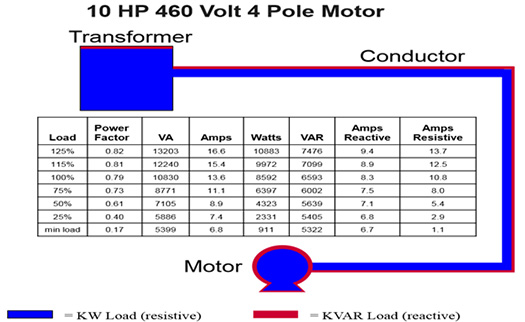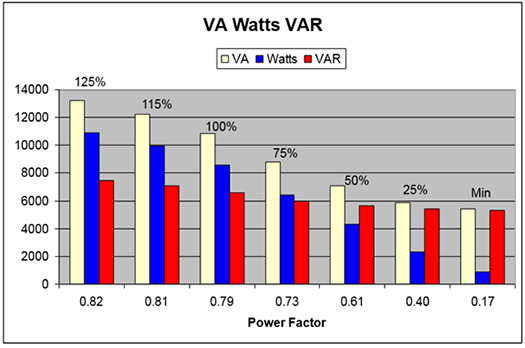Commercial Power Factor Billing Impact
What is power factor?
- Power factor is how efficiently power is being used in a system.
- Real power is the measured kilowatts (kW) a utility bills demand for. This is the energy that is actually performing the work (Resistive loads).
- Reactive power is the measured kilovolt-amperes reactive (kVAR) that is the non-working power caused by the magnetizing current required to operate devices (inductive loads).
- Apparent power measured in kilovolt-amperes (kVA) is the true amount of power being used.
The power triangle


(Courtesy U.S. Dept. of Energy)
- As indicated in the illustration, as a power factor becomes lower (more kVAR) the horse is pushed further off to the side of the tracks. This causes the horse (utility generation) to work harder while still only producing the same amount of work (pulling the cart down the track).
- The low power factor causes the entire system of both generation and delivery to become inefficient.
Motor power factor example


Low power factor, inductive loads
- Unlike resistive loads that create heat, inductive loads require the current used to create magnetic fields. The magnetic fields don’t produce any desired work.
- The total or apparent power (kVA) required by an inductive load is composed of both real and reactive power.
Why utilities care about power factor
- Utilities have to generate the total apparent power (kVA) a customer uses. If a customer has low power factor the utility needs to be able to recover for the extra generation they must produce and the extra losses it causes on the system.
- All of the utility equipment is sized in kVA. Without tracking power factor the utility may have equipment which is under sized or over utilized in the field that they don’t know about.
How does it affect customers' bills?
- Minnesota Power bills based on average power factor over the billing period.
- The average power factor seen adjusts the demand charges for the customer. We only look at power factor on rates that bill demand which include General Service (including non-demand), Large Power, Municipal Pumping and Large Light and Power. Regarding VA - our system losses increase exponentially with proportional power factor.
- Minnesota Power starts adjusting for power factor at 90.
- The amount of increased demand charge for low power factor is the difference between measured and billed KW.
http://www.mnpower.com/CustomerService/Rates
Rate Book General Service Rate 25
Rate Book LLP Rate 55 & 75
Rate Book Municipal Pumping Rate 87
| Power Factor Adjustment | |
|---|---|
| Example | |
| The highest 15-minute kilowatt demand during the billing period | 100 kW |
| Average power factor for the billing period | 70% |
| Calculation | |
| Billed kW = 100 kW x 0.90 power factor / 0.70 power factor = | 129 kW |
Correcting low power factor
- It is more cost effective for the customer to fix power factor issues on their side than the utility on the distribution or transmission system. The closer to the source power factor is corrected the better the solution.
- Typically, low power factor is corrected with the installation of power factor correction capacitors. Installing equipment like this requires some engineering work. Minnesota Power does not provide these services. Customers must hire their own consultant/contractor.
Let Minnesota Power's Power of One® Business program assist you with a personalized approach to help you increase the effectiveness of how you use energy in your facility through design assistance, rebates and incentives.
Benefits of correcting power factor
- Utility saves money on fuel for generation and utility system runs more efficiently.
- Customer’s bill will be lowered when they are no longer being penalized.
- Customer’s electrical system will be more efficient.
- Branch capacity will increase.
- Power losses will decrease.
Other resources:
http://www.energy.gov/eere/amo/downloads/reducing-power-factor-cost


